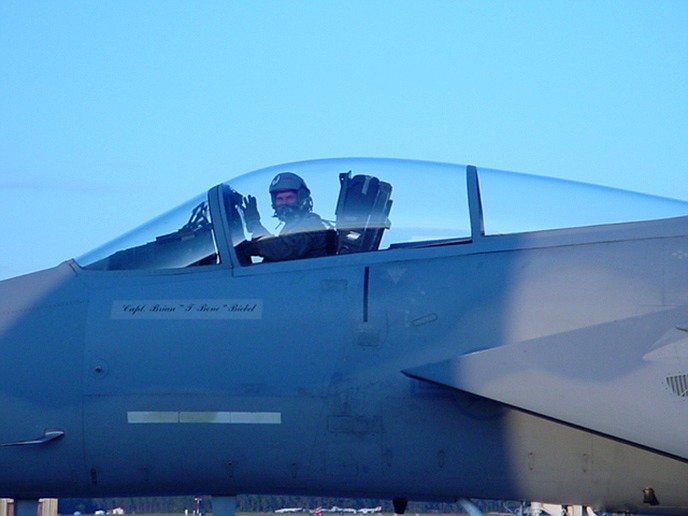Terry Walker has enjoyed a range of experiences of which others may only dream. From playing football at the University of Missouri to breaking the sound barrier, the retired fighter pilot praises his training in the Air Force as establishing the foundation for his many achievements.
A 1985 graduate of Jefferson City High School, where he began his football career, Walker was offered the opportunity to attend the Air Force Academy - a commitment, he explains, for which he was not yet prepared.
"I realized the academy was really hard work," said Walker, 47, Jefferson City. "But my first priority was to fulfill my wish of playing football for my homestate university."
Walker attended MU for the next two years where he realized his dream of playing football for the Tigers. But in the summer of 1987, he shifted his educational journey down a path previously sidestepped.
Transferring to the Air Force Academy in Colorado Springs, Colo., the young recruit's change of mind was "based upon a realization that I wasn't going to play professional football and knowing I'd get a great education."
For the next four years, he averaged 18-20 credit hours on the academic side while at the same time training to become an Air Force officer.
"The thing that stuck out to me the most (at the academy) was the level of discipline required to be successful," he said. "The system had a way of finding your weaknesses and then forcing you to strengthen those weaknesses."
He graduated on May 29, 1991, with a bachelor's degree in general engineering and was commissioned a second lieutenant. Walker then transferred to Vance Air Force Base (AFB) in Oklahoma to begin his initial pilot training.
"At that time (at the academy), you underwent a physical during your senior year to determine if you were pilot eligible," he said. "If you qualified, you could then go to pilot training."
While at Vance AFB, he spent the next year learning to fly: first on a T-37 subsonic jet and, during the second phase of training, in a T-38 Supersonic Advanced Trainer.
Since he graduated second in the program, he was able to stay at Vance for the next three years as an instructor pilot, training new pilots entering the same program he had just completed.
The airman was then deployed to South Korea as an air liaison officer with the Army's 2nd Infantry Division in 1996.
However, the following year he continued his own instruction when he was selected for qualification training on the F-15 Eagle (a twin engine, tactical fighter) at Tyndall, AFB in Florida.
During the next six months, Walker notes, "We learned the basic aspects of flying and employing the aircraft."
A single-seat fighter, the former pilot described the F-15 experience: "Flying the airplane is actually simple; the hard part of employing the fighter is using the radar and weapons systems," which, he added, takes years of practice.
Walker was then transferred to Kadena AFB in Japan in early 1998 for a 3½ year tour that included two deployments in the cockpit of an F-15.
"I first deployed to Turkey as part of Operation Northern Watch," he said. "It was a 3-month assignment during which we enforced the no-fly zone in northern Iraq."
His second tour, Walker added, was to Saudi Arabia during Operation Southern Watch - a 4-month deployment to enforce the no-fly zone in southern Iraq.
"Our missions usually consisted of 2-3 combat sorties a week patrolling the skies for the no-fly zones put in place after the first Gulf War," he said. "Occasionally you'd get some excitement, but overall it was generally quiet."
Walker then transferred to Tyndall AFB for a four-year assignment as an instructor training new F-15 pilots. From there, he spent a year at the Air Force Institute of Technology where he earned his master's degree in systems engineering in 2006.
After a three-year tour at Langley AFB in Virginia working in programs supporting the F-15C, his career made a full circle when he returned to the place his flying career began - Vance AFB. In May 2013, he retired at the rank of lieutenant colonel while serving as a T-38 instructor.
Returning to his hometown of Jefferson City less than a year ago, the married father of three sons now teaches two classes at Simonsen Ninth Grade Center and is an assistant football coach for the Jefferson City Jays.
While reflecting on a military career exceeding more than two decades, the former fighter pilot is not hesitant in recommending a similar career path to youth seeking a little post-high school direction.
"I believe the military is a great career ... but it's not without sacrifice," he said. "Though you may be asked to sacrifice time away from your family and to postpone your own goals to accomplish the goals of a team, it is a great choice for those who are uncertain what they want to do in life."
In closing, he added, "It provides the opportunity and the knowledge to determine who you are as a person and where you want to go in your life."
Jeremy P. Ämick writes on behalf of the Silver Star Families of America.

